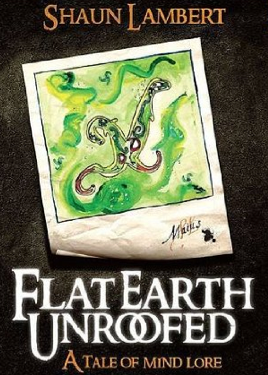
Shaun Lambert is a Baptist minister who likes to break category and convention. Whilst he leads a church in Stanmore, in the suburbs of North London, he has been developing a voice into spiritual territory that is anything but suburban. Writing and speaking on radio into the area of mindfulness, crossing the great divide between church and world, we glimpsed Shaun’s voice in his
A Book of Sparks, published in 2012. However, little in that first book prepared me for the surprise I would find when I opened the first page of
Flat Earth Unroofed, a tale of mind lore.
What unfolds is a new world conjured from thin air. The author himself confesses that he has spent much of his own life inhabiting other worlds in his imagination. This one, the world of the Island of Ge, is perhaps but one of those. It is a world intense with shadow and sharp edges that is, to the reader, almost instantly memorable, the coloured plates adding a delightful almost mediaeval illumination to the text.
Perhaps memorable is the right word, for within the cosmology that Lambert depicts, the act of forgetting is the curse which has befallen the world of Ge. Captured by the Fowler and held under the power of his Mirror of Forgetting, the inhabitants of Ge have forgotten many things. It is the quest of the hero Hudor, to re-draw their world so that what has been lost can be recovered.
Essentially a quest tale, the plot follows the journey of Hudor to first rescue Mimne, the Fowler’s daughter. From here the adventure gathers pace, as we are introduced to a bewildering array of characters or types; Eia, Bruiser (strangely out of step with the other mythological names), Chronos, Agonistes; winged dogs, flying snakes and silver weaving spiders. The names feel heavy with allusion and meaning - Neos, Origen, Chronos - though the author leaves us to decipher their potential significance.
Shaun Lambert’s
A Book of Sparks was a reading of mindfulness through St Marks’ gospel and we hear the echo of the saint’s narrative style and form in the writing here. Events are introduced abruptly; there are sharp narrative turns, drama and climax follows one after the next; brutality is swiftly administered and jarred emotional response is left untended; characters such as the Patterner or the Refuser appear and disappear and one is left wondering what part they may yet have to play in a story which is told in sharp fragments.
Some of the fantasy typology is familiar to us: wraiths, spawn and female warriors echo wider fantasy mythologies. But Lambert also breaks category time and again; the snake is good, the bee is all seeing, spiders heal with their webs. Who, for example, would have conceived of the otter as the animal figure through which we are transformed? This is enlivening, breathing freshness into a potentially well worn form. Indeed, perhaps the most important contribution of the book is linguistic. The author creates some startling new language which in itself weaves the fabric of a genuinely novel world.
Take the opening sentence ‘And so it begins, with the forgetting of colour, the colour of flight’; it is a sentence containing such a startling idea which just leaps out and grabs you. We are told that the Necromancer is ‘unsouled....another intelligence was there in shadow’; is this a dissection of the fallen man? And what does it mean for a soul to be ‘unhouselled’? If it comes to that, what does it mean for a flat earth to be unroofed? These are genuinely novel ideas not just wrapped up in neologism but crafted through it; you feel the warp and weft of theology being woven into an almost new fabric of cosmology and anthropology.
Indeed, perhaps there is. Shaun Lambert has been preoccupied in his work and writing with recovering the art of mindfulness; of being fully present, or paying attention, of noticing and moving in time. So it is no surprise to find that Hudor’s gift lies in his ability to pay attention, to find that still centre, to move into a different flow of time. Reality is found through a tunnel, into another time and space that exists in parallel to the closed-in mirrored universe. The author’s mind craft and time craft seem to me, possibly, to be a non-religious lexicon for the Christian journey into the Spirit, which St Paul depicts in Romans 8.
As a tale,
Flat Earth Unroofed ends unfinished. The cliff hanger retains an ominous shadow, as well as introducing upon the tip of a sword, a spider of hope. There is more to come and I suspect Shaun Lambert will continue to both settle and unsettle us with the second episode of Hudor and Mimne when it arrives.
Fantasy has become an overly worn genre. We might ask ourselves, do we need another contribution? I would suggest only if the conjured world can genuinely open a doorway into a deeper stream behind the cluttered, surface world of images and sounds in which we live today. I think
Flat Earth Unroofed might just achieve that. At the very least it is a startling, vivid, unusual invitation which will reward all but the most un-souled of readers.